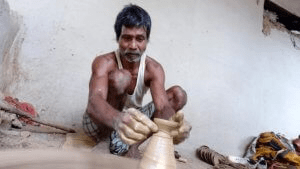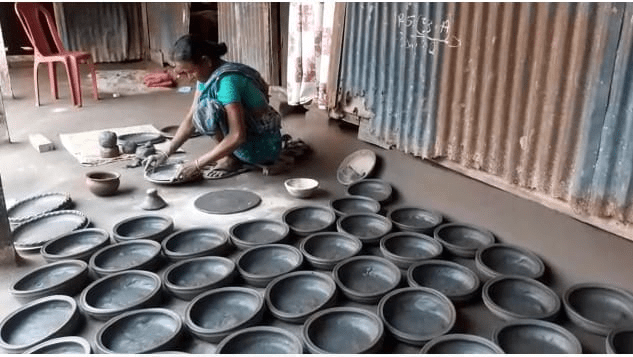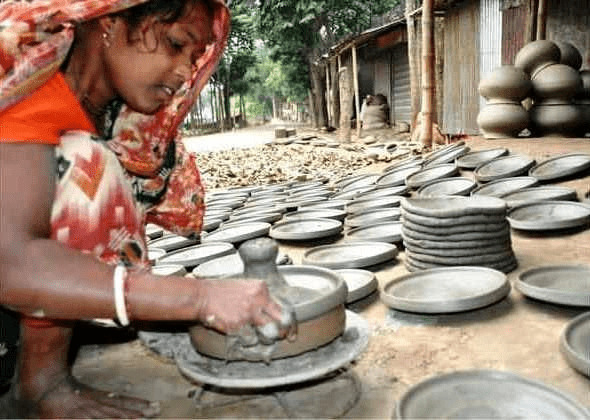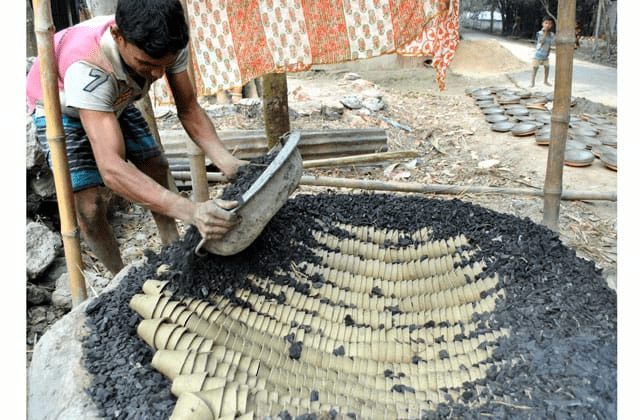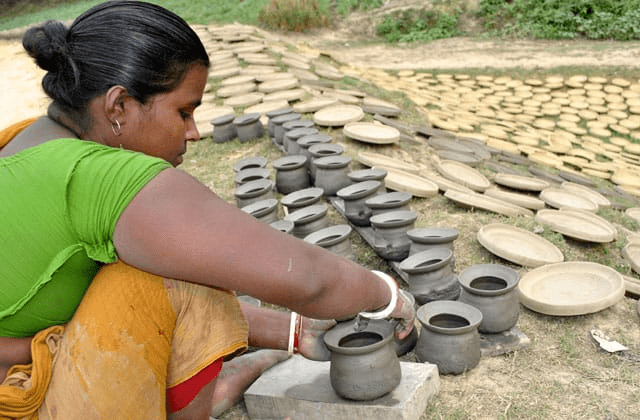জয়দীপ মৈত্র,দক্ষিণ দিনাজপুর : শীত মানেই নলেন গুঁড়ের মিষ্টি সুবাস। শীত মানেই পিঠে-পায়েস। আর পিঠে পায়েসের উত্সব মানেই পৌষ পার্বণ। পৌষ পার্বণের দিন এগিয়ে আসার সাথে সাথেই মৃত্ শিল্পীদের ব্যস্ততা তুঙ্গে। কয়েকদিন ধরেই চরম ব্যস্ততায় নাওয়া-খাওয়া প্রায় ভুলেই গিয়েছেন দক্ষিণ দিনাজপুর জেলার মৃত্ শিল্পীরা। বাঙালীর বারো মাসে তেরো পার্বণের অন্যতম পার্বণ হল পৌষপার্বণ। ‘মাসিমা মালপোয়া খামু’ বাংলা সিনেমায় এই বিখ্যাত প্রবাদ যা প্রতিটি বাঙালী বাড়ির অন্দরমহলের অন্তর্নিহিত কথা সেই সময় সিনেমায় প্রকাশ পেয়েছিল। এখনও শীতের সময়টাতে প্রতিটি বাঙালীকে পিঠে পুলির উত্সব অর্থাত্ পৌষ পার্বণ উত্সবে মেতে উঠতে দেখা যায়। পূর্বে শহর থেকে গ্রাম একান্নবর্তী পরিবার ছিল সর্বত্রই। ঠাকুরমা, মাসিমা, দিদিমারা প্রতি বছর শীত পড়তেই ঢেঁকিতে চালের গুঁড়া তৈরি করে রৌদ্রে শুকিয়ে তা কৌটোযাত করতেন। আর পৌষ পার্বণের দিনে বাড়ির মহিলারা সকাল থেকেই গোটা বাড়ি গোবর দিয়ে লেপে সুন্দর সুন্দর আলপনা আঁকতেন। দুপুর হতে না হতেই চালের গুঁড়োর সাথে চিনি অথবা নলেন গুড় অর্থাত্ খেজুরের গুড় মিশিয়ে পিঠে পুলি তৈরির উপকরণ তৈরি করে ফেলতেন। পৌষ সংক্রান্তির দিন সন্ধে হতেই গৃহস্থ বাড়িতে শুরু হয়ে যেত রকমারী পিঠে পুলি বানানোর কাজ। এই পিঠে পুলি তৈরি করতে প্রয়োজন মাটির তৈরি সরা। 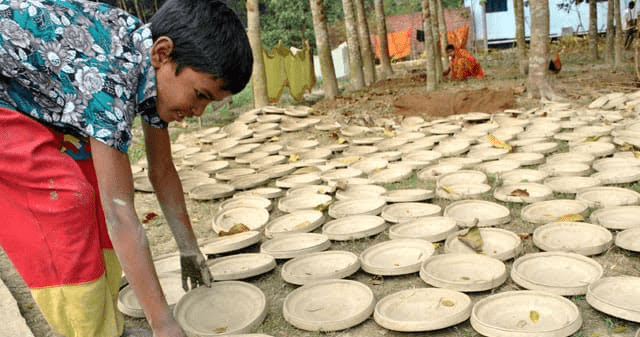 এটি তৈরি করতে বেশ কয়েকদিন ধরে অক্লান্ত পরিশ্রম যাচ্ছেন দক্ষিণ দিনাজপুর জেলার বিভিন্ন পাল পাড়ার মৃত্ শিল্পীরা। শীতের শৈত্য প্রবাহকে উপেক্ষা করে এঁটেল মাটির সাথে প্রয়োজন মতো জল মিশিয়ে বেশ কয়েক ঘণ্টা ধরে সেই মাটিকে মাখিয়ে সরা তৈরির উপযোগী করে তোলা হয়। এরপর নরম মাটিকে সাঁচে ফেলে বিভিন্ন আকৃতির সরা তৈরি করা হয়। কোনও সরার নাম এক খুঁটির সরা আবার কোনটা সাত খুঁটির সরা। প্রতিটি সরার জন্য একটি করে মাটির ঢাকনাও তৈরি করেন মৃত্শিল্পীরা। চলতি ভাষায় এটি ঢাকন নামে পরিচিত।এরপর সেই সরাগুলিকে রৌদ্রে শুকিয়ে আগুনে পোড়ানো হয়। তারপর সেগুলিকে একটি একটি করে বাছাই করে তা পাইকারি ও খুচরো হিসেবে বিক্রি করা হয়। আকৃতি অনুযায়ী বিভিন্ন ধরণের সরা সহ ঢাকনার দামও বিভিন্ন রকম হয়। জেলার গঙ্গারামপুরের মৃত্ শিল্পী লক্ষ্মী পাল, কল্পনা পালরা জানান, শীতে অক্লান্ত পরিশ্রম করে সরা, ঢাকন তৈরি করলেও এখন আর আগের মত সরা-ঢাকনের চাহিদা নেই। কারণ বর্তমানে শীতের দিনগুলিতে হাটে-বাজারে পিঠে-পুলি বিক্রি হয়। বাড়িতে পিঠে পুলি বানানো এখন আর অনেকেই নিজের ঘাড়ে নিতে চান না। জেলার আরেক মৃত্ শিল্পী দীনেশ পাল, দেবেন্দ্র পালরা জানান, ‘সরা, ঢাকন বিক্রি আগের থেকে অনেক কমে গেছে।তার উপর মাটি সহ জ্বালানী খরচ বাড়লেও সেই অনুপাতে সরা, ঢাকনের দাম পাওয়া যায় না। বাপ ঠাকুরদার ব্যবসা ঠিকিয়ে রাখতে আমরা এই পেশাকে আঁকড়ে ধরে থাকলেও নতুন প্রজন্ম এই পেশা থেকে দূরে সরে যাচ্ছে’। তবে পৌষ পার্বণের আগে দক্ষিণ দিনাজপুর জেলার বিভিন্ন মৃৎশিল্পীরা মাটি সরা বানাতে ব্যস্ত।
এটি তৈরি করতে বেশ কয়েকদিন ধরে অক্লান্ত পরিশ্রম যাচ্ছেন দক্ষিণ দিনাজপুর জেলার বিভিন্ন পাল পাড়ার মৃত্ শিল্পীরা। শীতের শৈত্য প্রবাহকে উপেক্ষা করে এঁটেল মাটির সাথে প্রয়োজন মতো জল মিশিয়ে বেশ কয়েক ঘণ্টা ধরে সেই মাটিকে মাখিয়ে সরা তৈরির উপযোগী করে তোলা হয়। এরপর নরম মাটিকে সাঁচে ফেলে বিভিন্ন আকৃতির সরা তৈরি করা হয়। কোনও সরার নাম এক খুঁটির সরা আবার কোনটা সাত খুঁটির সরা। প্রতিটি সরার জন্য একটি করে মাটির ঢাকনাও তৈরি করেন মৃত্শিল্পীরা। চলতি ভাষায় এটি ঢাকন নামে পরিচিত।এরপর সেই সরাগুলিকে রৌদ্রে শুকিয়ে আগুনে পোড়ানো হয়। তারপর সেগুলিকে একটি একটি করে বাছাই করে তা পাইকারি ও খুচরো হিসেবে বিক্রি করা হয়। আকৃতি অনুযায়ী বিভিন্ন ধরণের সরা সহ ঢাকনার দামও বিভিন্ন রকম হয়। জেলার গঙ্গারামপুরের মৃত্ শিল্পী লক্ষ্মী পাল, কল্পনা পালরা জানান, শীতে অক্লান্ত পরিশ্রম করে সরা, ঢাকন তৈরি করলেও এখন আর আগের মত সরা-ঢাকনের চাহিদা নেই। কারণ বর্তমানে শীতের দিনগুলিতে হাটে-বাজারে পিঠে-পুলি বিক্রি হয়। বাড়িতে পিঠে পুলি বানানো এখন আর অনেকেই নিজের ঘাড়ে নিতে চান না। জেলার আরেক মৃত্ শিল্পী দীনেশ পাল, দেবেন্দ্র পালরা জানান, ‘সরা, ঢাকন বিক্রি আগের থেকে অনেক কমে গেছে।তার উপর মাটি সহ জ্বালানী খরচ বাড়লেও সেই অনুপাতে সরা, ঢাকনের দাম পাওয়া যায় না। বাপ ঠাকুরদার ব্যবসা ঠিকিয়ে রাখতে আমরা এই পেশাকে আঁকড়ে ধরে থাকলেও নতুন প্রজন্ম এই পেশা থেকে দূরে সরে যাচ্ছে’। তবে পৌষ পার্বণের আগে দক্ষিণ দিনাজপুর জেলার বিভিন্ন মৃৎশিল্পীরা মাটি সরা বানাতে ব্যস্ত।
Joydeep Maitra, South Dinajpur: Winter does not mean the sweet aroma of powder. Winter means back. And the festival of pies on the back means Paush Parvan. As the day of Paush Parvan approaches, the busyness of dead artists peaks. The dead artists of South Dinajpur district have almost forgotten to eat and drink in extreme busyness for a few days. Paushparvan is one of the thirteen Parvans in the twelve months of Bengali. ‘Masima Malpoa Khamu’ This famous proverb in Bengali cinema which is the innermost saying of every Bengali home was revealed in the cinema at that time. Even in the winter season, every Bengali can be seen celebrating Pith Puli festival i.e. Poush Parban festival. In the past, families were everywhere, moving from the city to the village. Grandmothers, aunts, and grandmothers used to prepare rice powder and dry it in the sun every year in winter. And on the day of Paush Parban, the women of the house would paint the whole house with dung and draw beautiful Alpanas. Before noon, they used to mix rice powder with sugar or Nalen gur i.e. date molasses to make puli. On the day of Paush Sankranti, the work of making Puli on various backs would start in the household. To make a pulley on this back, you need clay mortar. The artists of different Pal Paras of Dakshin Dinajpur district have been working tirelessly for several days to make it. Ignoring the cold flow of winter, clay soil is mixed with water as needed and kneaded for several hours to make it suitable for making sara. The soft clay is then molded into various shapes. A shift is called a shift of one pole and another is a shift of seven poles. The potters also make a clay lid for each sara. In current language it is known as dhakan. Then the sara are dried in the sun and burnt in fire. Then they are sorted one by one and sold as wholesale and retail. The prices of the lids also vary depending on the shape and the different types of lids. The artists Lakshmi Pal, Kalpana Palra of Gangarampur in the district said that they worked tirelessly in winter to make sara and dhakan, but now there is no demand for sara-dakan like before. Because at present pithe-puli is sold in the market during the winter days. Many people do not want to take it upon themselves to make a pulley at home. Dinesh Pal, another artist of the district, Devendra Palra said, ‘The sale of Sara, Dhakan has decreased a lot from earlier. On top of that, the cost of fuel including soil has increased, but the price of Sara, Dakan is not available in that proportion. Although we cling to this profession to fix the business of father and grandfather, the new generation is moving away from this profession. However, before Paush Parban, various potters of Dakshin Dinajpur district are busy making mud sara.



